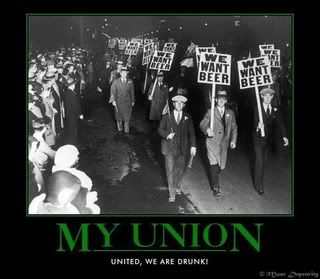


During Prohibition, the manufacture, transportation, import, export, and sale of alcoholic beverages were restricted or illegal. Prohibition was supposed to lower crime and corruption, reduce social problems, lower taxes needed to support prisons and poorhouses, and improve health and hygiene in America. Instead, Alcohol became more dangerous to consume; organized crime blossomed; courts and prisons systems became overloaded; and endemic corruption of police and public officials occurred.
In 1919, the requisite number of legislatures of the States ratified The 18th Amendment to the Federal Constitution, enabling national Prohibition within one year of ratification. Many women, notably the Women’s Christian Temperance Union, had been pivotal in bringing about national Prohibition in the United States of America, believing it would protect families, women and children from the effects of abuse of alcohol. Prohibition began on January 16, 1920, when the Eighteenth Amendment went into effect. Federal Prohibition agents (police) were given the task of enforcing the law. Even though the sale of alcohol was illegal, alcoholic drinks were still widely available at "speakeasies" and other underground drinking establishments. Many people also kept private bars to serve their guests. Large quantities of alcohol were smuggled in from Canada, overland and via the Great Lakes. While the government cracked down on alcohol consuption on land it was a different story on the water where they argued that ships outside the 3 mile limit were exempt. Needless to say, this technicality was exploited by everyone including the State owned shipping line. Legal and illegal home brewing was popular during Prohibition. Limited amounts of wine and hard cider were permitted to be made at home. Some commercial wine was still produced in the U.S., but was only available through government warehouses for use in religious ceremonies, mainly for communion. "Malt and hop" stores popped up across the country and some former breweries turned to selling malt extract syrup, ostensibly for baking and "beverage" purposes. Whiskey could be obtained by prescription from medical doctors. The labels clearly warned that it was strictly for medicinal purposes and any other uses were illegal, but even so doctors freely wrote prescriptions and drug-stores filled them without question, so the number of "patients" increased dramatically. No attempt was made to stop this practice, so many people got their booze this way. Over a million gallons were consumed per year through freely given prescriptions. Because Prohibition banned only the manufacturing, sale, and transport - but not possession or consuming of alcohol, some people and institutions who had bought or made liquor prior to the passage of the 18th Amendment were able to continue to serve it throughout the prohibition period legally. Even prominent citizens and politicians later admitted to having used alcohol during Prohibition. President Harding kept the White House well stocked with bootleg liquor, though, as a Senator, he had voted for Prohibition. This discrepancy between legality and actual practice led to widespread comtempt for authority. Over time, more people drank illegally and so money ended up in gangsters' pockets. Prohibition also presented lucrative opportunities for organized crime to take over the importing ("bootlegging"), manufacturing, and distributing of alcoholic drinks. Al Capone, one of the most infamous bootleggers of them all, was able to build his criminal empire largely on profits from illegal alcohol. The American grape growing industry was largely situated in California where there were about 700 bonded wineries producing table wines. Initially, prohibition forced the closure of most of the wineries when growers pulled up their vines thinking their market had evaporated. This created an enormous shortage of grapes forcing the the price per ton to rise 1000% and more from $20 to over $200. Growers realizing their mistake replanted vineyards but in their greed planted much greater acreages than previously. The increased supply forced the price per ton down to $15 by the end of prohibition. Every passing year the number of repeal organizations and demand for repeal increased. In 1932, the Democratic Party's platform included a promise to repeal Prohibition, and Franklin Roosevelt ran for President promising to repeal of federal Prohibition laws. By then, an estimated three quarters of American voters, and an estimated forty-six states, favored repeal. In 1933, the legislatures of the states ratified the Twenty-first Amendment, which repealed Amendment XVIII and prohibited only the violations of laws that individual states had in regard to "intoxicating liquors". Federal Prohibitionary laws were then repealed. Some States, however, continued Prohibition within their own jurisdictions. Almost two-thirds of the states adopted some form of local option which enabled residents to vote for or against local Prohibition; therefore, for a time, 38% of Americans still lived in areas with Prohibition. By 1966, however, all states had fully repealed their state-level Prohibition laws.
Found on http://www.1920-30.com/prohibition/






Very good post. Pictures are well chosen to represent post. I love your background. Just work on sidebar images. 75/75
ReplyDeleteMs. Donahue